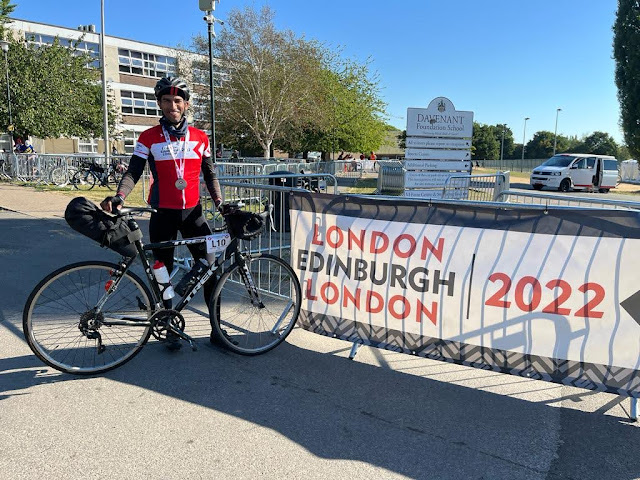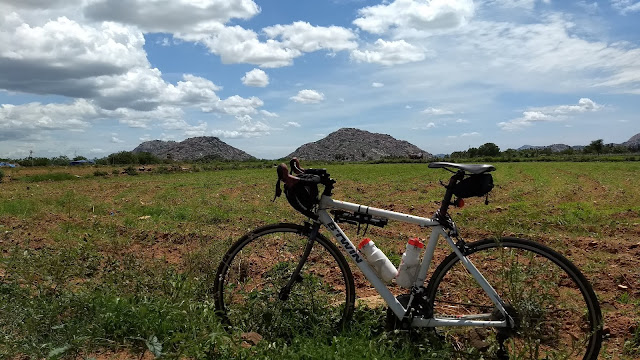LEL 2022 - Minimum Distance and Speed Requirement and Training
London Edinburg London (LEL)
2022 Edition
7 August to 12 August
Distance: 1,520 kilometers
Maximum time: 125 hours and 100 hours
About the ride:
London–Edinburgh–London (LEL) is a randonnée bicycle
event of approximately 1,500 kilometres (930 miles) over an out-and-back course
between the capital cities of London (England) and Edinburgh (Scotland). LEL is
the flagship event of Audax UK, it is held every four years. The 2021 (being
held in August 2022 due to the covid pandemic) ride will be the 9th edition
of LEL.
The ride starts at Central London for the 100 hour
batch and from Davenant School, Debden for the 125 hour batch. Over 2,000
riders are participating in the event. The 100 hour batch starts at 5:00 am
from Central London and the 125 hour is divided into batches of 40-60 riders in
each batch with the start times for each batch being 15 minutes apart.
The route has 19 control points (excluding the start and
end controls). The average distance between controls is 60
kilometers. The maximum distance between two controls is about 110 kilometers;
between Malton and Barnard Castle on the way in and out and also between Moffat
and Dunfermline.
Mileage and Speed Requirement:
For the 125 hour batch
|
Distance (kilometers) |
Total Time (hours) |
Speed (kmph) |
|
1,520 |
125 |
12.16 |
Daily Mileage Requirement
|
Total Time (hours) |
Speed (kmph) |
Distance (kilometers) |
|
24 |
12.16 |
292 |
The required minimum mileage per day for LEL is 292 kilometers. However, we do not stay on the saddle for 24 hours and we get off the saddle for the following:
- Control Point Stamping
- Food and hydration
- Rest
- Toilet breaks
- Drop bag access (charging of equipment/shower/change of clothes)
- Sleep (average of 2.5 hours per 24 hours)
On an average in a 24 hour bracket we spend 8
hours off the saddle for the above breaks. Since the clock does not stop in
randonneuring events, the required ride speed is as below:
|
Distance (kilometers) |
Ride Time (hours) |
Speed (kmph) |
|
292 |
16 |
18.25 |
Note 1:Average time that we spend on a drop bag access and sleep is 4 hours. Usually the first day riders do not access drop bags/sleep which gives an additional 4 hours of riding time, so on the first day we ride about 70 kilometers more provided we stick to the minimum average speed required of 18.25 kmph.
Note 2: Cutting down on
sleep will lead to hallucination and although we might get ahead of the required
mileage in the beginning, we run the risk of taking an extended break later on
**Disclaimer**:
The above data is referential information. Riders can analyse data from their past rides (average riding speed, sleep time, average time taken off the saddle) and see if they have met the minimum required daily mileage and plan accordingly to either increase the saddle time or increase their ride speed.
Kindly factor in the following while making a comparison:
- Weather conditions will be cold and wet as against hot and dry
- Elevation
- Road conditions: we will be on interior/rural roads where the road surfaces will be rough as against the ride on the highway which is on smooth surfaces. Rolling resistance will be higher on interior/rural roads and as a consequence our average speed will be lower.
- If the riders are from Bengaluru, note that we build a buffer at the start of the ride since Bengaluru is at an elevated height, we might not be able to build a buffer at the beginning as much as we do in Bengaluru
- Navigation - there might be some time loss since the roads are not familiar and navigating the course will cause a few delays
- Nutrition - our comfort foods may not be available and this might lead to drop in performance as well
Summary:
|
Category |
Distance (kilometers)* |
|
Exceed Expectation |
> 300 |
|
Meet Expectation |
300 |
|
Below Expectation |
< 300 |
*the minimum kilometers have been rounded off to 300
Riders can keep a track of the the distance covered
every 24 hours and try to stay ahead of the required mileage. Even a 10
kilometer excess on a daily basis makes it 40 kilometers lesser required on the
last day.
Note: On days when the
elevation is high and also in inclement weather the average ride distance is
250 kilometers, so kindly do not ease up or lose focus if you are far ahead of
the requirement, the elevation and weather in Scotland will be a big test and
so too will be the return in England with head winds expected on the flat
sections making it very difficult to meet the minimum required speeds/mileage
Training for the Event:
Countdown to the event: 2 months; 61 days
Effective training days remaining: 45-50 days
We have just about 1.5 months of time remaining to
train for the event. We have ridden long distances and pretty much know our
riding styles and nutrition requirements and how we react on the rides.What
time of the day and what weather conditions favour us and what are the times
when we do not ride well. How do we react when we are riding well and also when
we are not riding well.
We might not have been riding or might be feeling
under prepared for the event. We still have time and we have to find
the rhythm/form to ride. There is just enough time to improve our fitness
levels also by about 10% at least which will hold us in good stead during the
event.
Spending time on the saddle will go a long way in getting
back to form/getting our confidence back. However, how much saddle time is
required, the rider is the best judge for this.
The following approaches could be adopted:
Approach 1: Long rides
Long is a relative term, however, we do not need to do
many multi day rides. We can start with 200 kilometer rides and build up to about
700 kilometers by mid-July. Choose routes which closely mimic the event route. There
are many routes around Bengaluru where the elevation and flat sections with
wind can be practiced.
Approach 2:
Ride everyday with the focus being on time rather than
distance. Spend at least 1-2 hours everyday depending on the intensity of the
ride and 5-6 hour rides on the weekends, target being to get 18-20 hours of
riding every week (week here being 6 days with a day off). Ease up from 20 July
so that the body recovers, low intensity rides after this is sufficient.
Note: the hours spent
on riding should be meaningful hours and not hours spent riding in traffic or rides with
intermittent stops
If using an indoor trainer, get onto a base training
plan and try for a 10-15% improvement in your respective FTP. Riding on the
trainer will improve the fitness levels.
Can try a combined approach also, indoor training
plans alternate between interval training and recovery days. The interval
training can be done on the indoor trainer and the recovery rides on road so
that the feel for the weather conditions and bike handling is not lost.
Note:
1. The most important aspect at this stage is to stay injury free. There isn't enough time to recover from an injury
2. Look for small improvements rather than exponential improvement at this stage




Splendidly articulated and explained in simple language! Thanks Monish!
ReplyDelete